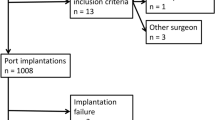Abstract
The purpose of this study was to evaluate whether low-profile totally implanted central venous port systems can reduce the late complication of skin perforation. Forty patients (age, 57 ± 13 years; 22 females, 18 males) were randomized for the implantation of a low-profile port system, and another 40 patients (age, 61 ± 14 years; 24 females, 16 males) received a regular port system as control group. Indications for port catheter implantation were malignant disease requiring chemotherapy. All port implantations were performed in the angiography suite using sonographically guided central venous puncture and fluoroscopic guidance of the catheter placement. Procedure time, number of complications (procedure-related immediate, early, and late complications), and number of explantations were assessed. Follow-up was performed for 6 months. All port implantations were successfully completed in both study groups. There were two incidents of skin perforation observed in the control group. One skin perforation occurred 13 weeks and the other 16 weeks after port implantation (incidence, 5%) in patients with regular-profile port systems. Two infections were observed, one port infection in each study group. Both infections were characterized as catheter-related infections (infection rate: 0.15 catheter-related infections per 1000 catheter days). In conclusion, low-profile port systems can be placed as safely as traditional chest ports and reduce the risk of developing skin perforations, which occurs when the port system is too tight within the port pocket.



Similar content being viewed by others
References
Teichgräber UK, Gebauer B, Benter T, Wagner HJ (2003) Central venous access catheters: radiological management of complications. Cardiovasc Interv Radiol 26:321–333
Chang HM, Hsieh CB, Hsieh HF et al (2006) An alternative technique for totally implantable central venous access devices. A retrospective study of 1311 cases. Eur J Surg Oncol 32:90–93
Zahringer M, Hilgers J, Kruger K et al (2006) Ultrasound guided implantation of chest port systems via the lateral subclavian vein. Rofo 178:324–329
Aldrighetti L, Paganelli M, Arru M et al (2000) Complications of blind placement technique in 980 subcutaneous infusion ports. J Vasc Access 1:28–32
Cil BE, Canyigit M, Peynircioglu B et al (2006) Subcutaneous venous port implantation in adult patients: a single center experience. Diagn Interv Radiol 12:93–98
Benter T, Teichgraber UK, Kluhs L et al (2001) Anatomical variations in the internal jugular veins of cancer patients affecting central venous access. Anatomical variation of the internal jugular vein. Ultraschall Med 22:23–26
Teichgräber UK, Benter T, Gebel M, Manns MP (1997) A sonographically guided technique for central venous access. AJR Am J Roentgenol 169:731–733
Wagner HJ, Teichgräber U, Gebauer B, Kalinowski M (2003) Transjugular implantation of venous port catheter systems. Rofo 175:1539–1544
Baskin KM, Jimenez RM, Cahill AM, Jawad AF, Towbin RB (2008) Cavoatrial junction and central venous anatomy: implications for central venous access tip position. J Vasc Interv Radiol 19:359–365
Crowley JJ, Pereira JK, Harris LS, Becker CJ (1998) Radiologic placement of long-term subcutaneous venous access ports in children. AJR Am J Roentgenol 171:257–260
Burbridge B, Krieger E, Stoneham G (2000) Arm placement of the Cook titanium Petite Vital-Port: results of radiologic placement in 125 patients with cancer. Can Assoc Radiol J 51:163–169
Lundberg G, Wahlberg E, Rickberg A, Olofsson P (1995) PAS-Port: a new implantable vascular access device for arm placement: experiences from the first two years. Eur J Surg 161:323–326
Hata Y, Morita S, Morita Y et al (1998) Peripheral insertion of a central venous access device under fluoroscopic guidance using a peripherally accessed system (PAS) port in the forearm. Cardiovasc Interv Radiol 21:230–233
Nosher JL, Bodner LJ, Ettinger LJ et al (2001) Radiologic placement of a low profile implantable venous access port in a pediatric population. Cardiovasc Interv Radiol 24:395–399
Silberzweig JE, Sacks D, Khorsandi AS, Bakal CW (2000) Reporting standards for central venous access. Technology Assessment Committee. J Vasc Interv Radiol 11:391–400
Wolf HH, Leithauser M, Maschmeyer G et al (2008) Central venous catheter-related infections in hematology and oncology: guidelines of the Infectious Diseases Working Party (AGIHO) of the German Society of Hematology and Oncology (DGHO). Ann Hematol 87(11):863–876
Nouwen JL, Wielenga JJ, van Overhagen H et al (1999) Hickman catheter-related infections in neutropenic patients: insertion in the operating theater versus insertion in the radiology suite. J Clin Oncol 17:1304
Elishoov H, Or R, Strauss N, Engelhard D (1998) Nosocomial colonization, septicemia, and Hickman/Broviac catheter-related infections in bone marrow transplant recipients A 5-year prospective study. Medicine (Baltimore) 77:83–101
Biffi R, de Braud F, Orsi F et al (1998) Totally implantable central venous access ports for long-term chemotherapy. A prospective study analyzing complications and costs of 333 devices with a minimum follow-up of 180 days. Ann Oncol 9:767–773
Author information
Authors and Affiliations
Corresponding author
Additional information
An erratum to this article can be found at http://dx.doi.org/10.1007/s00270-009-9540-8
Rights and permissions
About this article
Cite this article
Teichgräber, U.KM., Steitparth, F., Cho, C.H. et al. A Comparison of Clinical Outcomes with Regular- and Low-Profile Totally Implanted Central Venous Port Systems. Cardiovasc Intervent Radiol 32, 975–979 (2009). https://doi.org/10.1007/s00270-008-9477-3
Received:
Revised:
Accepted:
Published:
Issue Date:
DOI: https://doi.org/10.1007/s00270-008-9477-3




